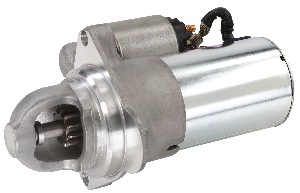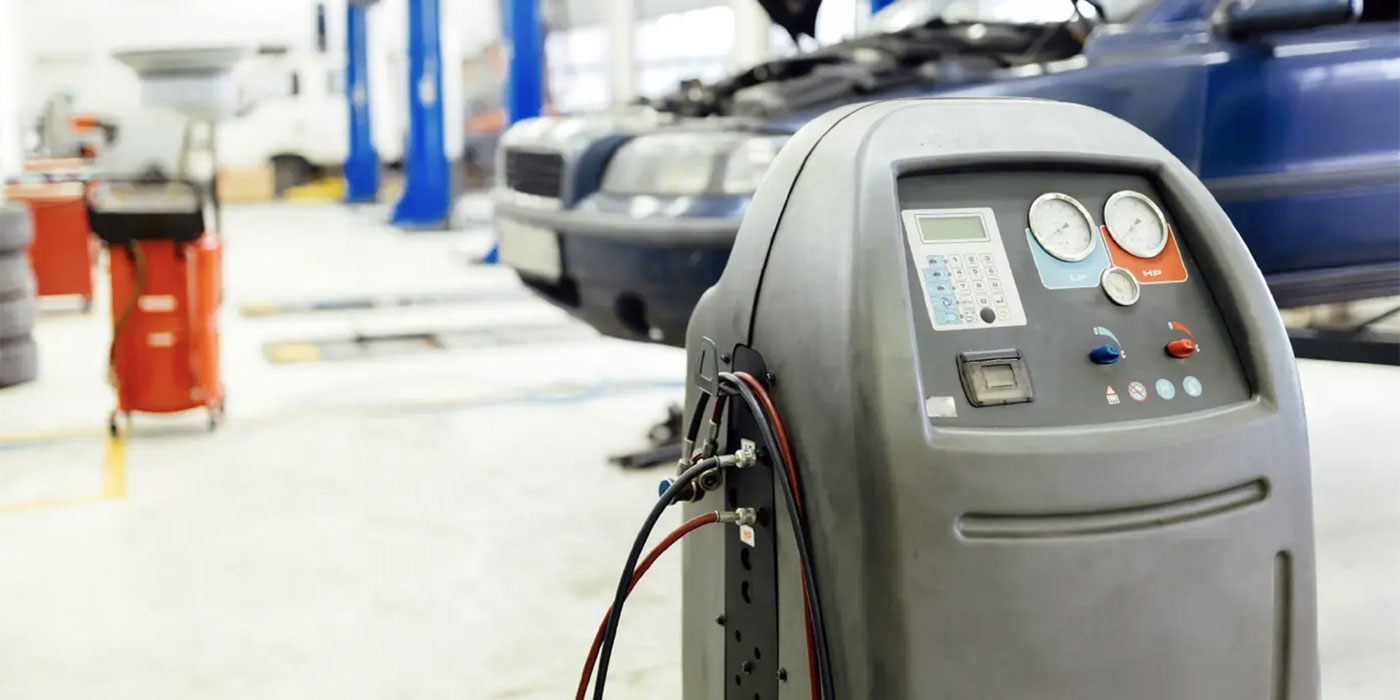It’s no secret that the first automobiles were started by hand cranking. It’s also pretty obvious that, somewhere along the way, someone replaced the hand crank with an electric motor.
In 1911, a friend of Henry Leland, founder of Cadillac, died from injuries sustained while restarting a car for a lady. The need for a starting method that did not risk personal injury became obvious to Leland. 
He commissioned Charles Kettering, head of Dayton Electrical Co. (Delco today), to come up with a better method. That better method was the electric starter motor. By 1912, electric starters were standard on all Cadillacs.
The “Bendix” on the starter has a bit of its own history as well. It was named after Vincent Bendix, who designed and patented the starter drive in 1910.
Between Kettering’s electric starter and Bendix’s starter drive, we now have the standard starter used in automobiles around the world today. Over the years, the size, shape, voltage ratings and control methods have changed. In spite of those changes, the starter operation and design has remained basically the same for nearly a century.
Construction & Operation
A lot has to happen before the “start” signal from the ignition switch can reach the starter assembly. The ignition switch simply sends a voltage signal through the safety switch to the starter solenoid. Some of the older systems used a starter relay, and some did not. In modern starting systems, the PCM is now the key to the operation. The starter relay will not be energized without a signal from the PCM.
Once the “start” signal reaches the starter assembly, more must happen before the engine begins to crank over. The “start” signal voltage enters the smaller diameter lug on the starter solenoid.
The starter solenoid windings are energized and pull the plunger inside the solenoid rearward. The front of the plunger is connected to a fork that pivots and engages the starter drive pinion into the engine’s flywheel. The teeth of the pinion gear are tapered in order to ease engagement into the flywheel.
At the farthest length of the plunger’s travel, the rear of the plunger pushes a contact plate against the two heavy gauge lugs in the rear of the solenoid. This completes an electrical path between the heavy gauge battery cable and down into the starter motor brushes. The brushes then transfer the electricity into the contacts on the armature, called the “commutator.”
The armature is then magnetically charged. The magnetic fields in the armature push against the magnetic fields of the permanent magnets. After all of that, the starter begins to rotate, and, in turn, rotates the engine. The starter drive (or Bendix) contains an over-running clutch (one-way clutch) that protects the starter when the engine fires up.
As small of a package as the starter is, it is a little powerhouse. When measuring an electric motor, horsepower is rarely used. Usually, they are rated in watts. The typical starter for a gasoline 4-cylinder engine has a wattage rating between 1,000 and 1,200 watts.
How much power is that exactly? One horsepower is equal to 745.699 watts. That means that a 1,200-watt starter, for a 4-cylinder engine, is approximately 1.6 hp.
Not impressed yet? Ok, think about this. One horsepower is the ability to lift 33,000 pounds of weight one foot in the air in one minute.
That means that a 4-cylinder starter motor, at around 1.6 hp, has enough force to lift about 52,800 lbs. (or 26.4 tons) of weight one foot within one minute. That’s a bit more impressive when looked at that way, isn’t it?
When it comes to the larger starters for big diesel engines, horsepower readings can reach 13 hp! When bench testing a starter, care must be taken not to let anything get caught in the Bendix area. Damage to the starter and/or personal injury could result. If you are unfortunate enough to have a finger caught in the Bendix, the starter probably won’t even slow down.
Diagnostic Tips
As with anything else, you first need to know about the system you are working on. Is it a conventional starter system or is it a modern system where the PCM can lock out the starter? Just because it has a factory security system doesn’t mean the system has the ability to deny the starter.
Be sure to familiarize yourself with the make and model by reading the “description and operation” listed in your information system. If you’re good with reading wiring diagrams, a glance over the diagram can reveal its secrets of operation.
For this discussion, “relays” and “solenoids” will be defined as such:
Relay: A device that uses an internal electromagnet to cause an internal switch to overcome spring tension and either complete or break an electrical circuit. A relay is only capable of transferring electrical energy. An example of a relay would be a cooling fan relay.
Solenoid: A device that uses an internal electromagnet to cause an internal plunger device to overcome return spring tension in order to move and transfer mechanical energy. A solenoid may also be used to complete an electrical path in conjunction with a mechanical output, such as in the case of a starter solenoid on top of a starter. The high-amperage fender mount relay used by Ford is NOT a solenoid, although it is often mistakenly referred to as such, even by manufacturers. It only transfers electrical energy and thus is considered a relay.
Usually, with any starting system-related complaint, listening is your best front-line diagnostic tool.
If the engine cranks over, listen for possible stripping sounds of gear clash. Stripping sounds could be the result of a faulty over-running clutch in the starter drive, damaged or missing teeth on the flywheel, a solenoid that is energizing the armature before the drive gear has fully engaged the flywheel, a starter that is loose, or a mis-shimmed starter (there are still a few of those cars running the streets that are old enough to require shims, thanks to GM).
Does the starter motor free spin without rotating the engine? This could be a damaged over-running clutch in the Bendix, missing teeth on the flywheel or a broken gear drive engagement fork inside the starter.
Listen to the tone of the starter. Does it sound labored? A starter that has a deep and labored tone is often the result of a weak battery. This can also be caused by high resistance in the battery cables, an accessory on the drive belt resisting the engine from turning via the belt, a mechanically seizing engine or an internally failing starter. Typically, a failing starter will drag and labor more when hot than when cold.
If it doesn’t crank over at all, does it at least sound like the drive gear is kicking out into the flywheel? Listen for an audible “clunk” coming from the starter assembly.
If the Bendix engages the flywheel, but the armature of the starter doesn’t rotate, this could be caused by high resistance in the high amperage feed to the starter (like bad battery cable), an extremely weak battery, a bad contact plate in the back of the solenoid, or problems down in the starter motor, such as burned brushes.
Can you at least hear the starter relay (whether fender-mounted or inside of a junction box) clicking? If the starter relay will at least click, this is a solid indication that the ignition switch is good and the PCM doesn’t have the starter locked out for any reason. For most vehicles, this would also prove the neutral safety switch is good, as well.
This, however, does NOT prove the starter relay to be good. If the relay clicks, that only means the magnetic coil inside is energizing. That does not mean that the contact switch inside is able to transfer electrical energy.
Do the relays and solenoids click one time per key cycle or do they chatter? A relay or solenoid that is power- starved may not be able to generate enough magnetic field to hold the contact switch or plunger in position against its own internal spring tension. They will then often make a chattering, humming or buzzing sound when demanded to function.
A power-starved relay may be caused by a weak battery, high resistance in the wiring, high internal resistance to that one relay or solenoid, or high resistance in any switch, such as the ignition, that feeds the relay or solenoid.
A visual inspection can also be very revealing and can save a lot of wasted time.
Look at the battery cables. Are they corroded, broken or loose? Don’t forget to look at the battery cable ground at the engine block and the positive cable end at the back of the starter.
If there is no starter action at all, don’t forget to look for the indication of any anti-theft system – aftermarket or factory. Most anti-theft systems perform a starter interrupt.
For example, on Ford factory systems a telltale sign that the anti-theft has been activated is if the security light is flashing rapidly. In contrast, on a Ford, if you turn the key to the “on” position and the light goes out, then the factory anti-theft is not the cause of the no start/no crank condition.
On an automatic, is the transmission fully seated into Park? If so, try sliding the shifter to neutral and starting. If still nothing, check for reverse lights in the “R” position. This can point you to a faulty neutral switch faster.
On a manual transmission, look to make sure the floor mat hasn’t bunched up under the clutch pedal and is simply not letting the clutch pedal travel far enough.
Test Equipment Usage
Your test equipment doesn’t have to be fancy, but it does have to work properly and you must understand what it is telling you. Read any instructional material that is supplied with it.
Before you can identify measurements that are bad, you first must know what is good. Typical gasoline piston engines add 25 amps of starter draw per cylinder starting with 125 amps for a 3-cylinder engine. Therefore, a 4-cylinder engine is approximately 150 amps, a 5-cylinder engine is approximately 175 amps, a 6-cylinder engine is 200 amps, and so on.
Voltage drop testing should be performed with the proper leads. Have a partner attempt to start the engine. The ignition system should be disabled and care should be taken so no one gets injured by the moving parts under the hood.
Measure the voltage while cranking. If it is too high, then there is excessive resistance between the two points measured. Usually this is the cable at fault, but there can be other connections involved, such as the mounting surface between the starter housing and the engine block or transmission.
Typically, the positive side will have a voltage drop of about 0.2 volts (adding 0.1 volt more for fender mount relays that carry the high amperage flow like Ford products). Negative will typically be about 0.15 volts. Give a plus or minus to these generic figures of about 0.05 volts each for tolerance of your meter.
After the visual and audible inspections have been performed, you should have a good indication of the problem and what to test next.
Diagnostic Case Study
In this example case, a 1990 Ford Ranger truck with a V6, the vehicle would start but would drag on startup. It seems worse when the engine is hot vs. when it is cold.
At this point, a battery load test is performed. The battery passed the load test. The next logical test from here was a starter draw test. When placing an inductive ammeter on the battery positive cable and cranking, a reading of about 400 amps was found, approximately double what should be there.
Counter electromotive force is an electrical force that is generated by electric motors. That electrical force is induced into the armature of the electric motor and opposes the voltage from the source that is powering the motor.
This may be loosely symbolized by a wind resistance applied against a moving vehicle. The faster the vehicle moves and the more wind that blows against the front of the vehicle, the more the air resists the car’s forward movement, placing strain on the body and forcing the engine to work harder.
Anything that causes the starter to spin too slowly can cause the higher than normal current reading. Such things could be an engine that is mechanically held down from spinning over. To inspect this, the engine was spun by hand via the belt. No accessories appeared to be seized, and the engine rolled over with normal effort.
The next test was a voltage drop test. Why? Doesn’t high resistance lower the amperage draw of a component? Normally yes, but in the case of an electric motor, if the motor is power starved, it won’t spin over as fast as it should.
As we know, that will cause the motor to not produce enough CEMF. The battery is then allowed to push more current than normal through the armature.
The voltage drop test resulted in normal readings. The starter was at fault. The replacement starter had an average draw of 192 amps.
Compare for a moment the analog reading against the digital reading. The digital meter settled on the number 192 and varied very little from that measurement. However, the analog meter is rapidly cycling between 100 amps and 275 amps.
Why doesn’t the digital measurement cycle between the high and low? Digital meters display an average of the measurement.
This is important to keep in mind when using digital meters. Since they display only an average, some information could be withheld from the user.
In this case, the analog meter is fluctuating over a range of about 175 amps, so rapidly that the camera barely captures the needle’s image at all. Normally, you will see a fluctuation range of about 50 amps.
The extra large fluctuation can be caused by cylinders that are low on compression. The new starter fixed the problem at hand, but the possibility of engine mechanical failure looms as the “Ghost of Christmas Future” in the blurry movement of the analog ammeter.













